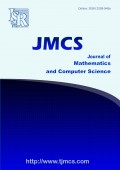Designing and Implementing a Distributed Genetic Algorithm for Optimizing Work Modes in Wireless Sensor Network
-
2498
Downloads
-
3672
Views
Authors
Mehdi Eslami
- Islaimic Azad University, Qeshm international branch, Qeshm, Iran.
Javad Vahidi
- Department of Applied Mathematics, Iran University of Science and Technology, Behshahr, Iran.
Majid Askarzadeh
- Islaimic Azad University, Saveh branch, Saveh, Iran.
Abstract
In this paper it is tried to present a solution for optimizing energy consumption in the sensors of wireless network by using distributed genetic algorithm and solving the famous problem of graph coloration. this idea formed by modeling sensors of wireless network by the help of graph and posing the problems of graph coloration with the description of work groups in scheduling nodes in wireless sensor networks. In this way we can save energy and conduct quality services in different time and place of wireless sensor network by determining some work groups in different time and different network tree node.
Share and Cite
ISRP Style
Mehdi Eslami, Javad Vahidi, Majid Askarzadeh, Designing and Implementing a Distributed Genetic Algorithm for Optimizing Work Modes in Wireless Sensor Network, Journal of Mathematics and Computer Science, 11 (2014), no. 4, 291 - 299
AMA Style
Eslami Mehdi, Vahidi Javad, Askarzadeh Majid, Designing and Implementing a Distributed Genetic Algorithm for Optimizing Work Modes in Wireless Sensor Network. J Math Comput SCI-JM. (2014); 11(4):291 - 299
Chicago/Turabian Style
Eslami, Mehdi, Vahidi, Javad, Askarzadeh, Majid. "Designing and Implementing a Distributed Genetic Algorithm for Optimizing Work Modes in Wireless Sensor Network." Journal of Mathematics and Computer Science, 11, no. 4 (2014): 291 - 299
Keywords
- Genetic Algorithm
- Wireless Sensor Network
- Graph Coloration
- Optimizing Energy Consumption
MSC
- 68T05
- 68W10
- 68T20
- 92B20
- 92D10
References
-
[1]
A. C. M. Ran, M. C. B. Reurings, A fixed point theorem in partially ordered sets and some applications to matrix equations, Proc. Amer. Math. Soc., 132 (2003), 1435–1443.
-
[2]
I. Akyildiz, W. Su, Y. Sankarasubramaniam, E. Cayirci, A Survey on Sensor Networks, IEEE Communications Magazine, 40 (2002), 102-116
-
[3]
G. J. Chaitin, Register Allocation and splitting via graph coloring , Proc. Of ACM SIGPLAN 82 Symposium on Compiler Construction, (1987), 98-105
-
[4]
D. S. Jobnson, C. R. Aragon, L. A. McGoach, C. Schevon, Optimization by simulated annealing: an exprimental evaluation, Part 2, graph coloring and number partitioing, Operations Research, 39(3) (1991), 378-406
-
[5]
David E. Golldberg, Genetic Algorithms in Search, Optimization and Machine Learning, Addison-Wesly Pub., (1989)
-
[6]
Su-Young Parka, Jung Hyun Choia, Sookyun Wangb, Seok Soon Parka, Design of a water quality monitoring network in a large river system using the genetic, algorithm, Ecological Modelling , 1 9 9 (2006), 289–297
-
[7]
W. Heinzelman, A. Chandrakasan, H. Balakrishnan, Energy-Efficient Communication Protocol for Wireless Microsensor Networks, In Proceedings of the 33rd Hawaii International Conference on System Sciences (HICSS '00), (2000)
-
[8]
I. Sim, K. Jin Choi, K. Kwon, Jaiyong Lee, Energy Efficient Cluster header Selection Algorithm in WSN, In Proceedings of IEEE International Conference on Complex, Intelligent and Software Intensive Systems, (2009), 584-587
-
[9]
D. Riordan Gupta, S. Sampalli, Cluster-head Election using Fuzzy Logic for Wireless Sensor Networks, In Proceedings of IEEE Communication Networks and Services Research Conference, (2005), 255- 260

